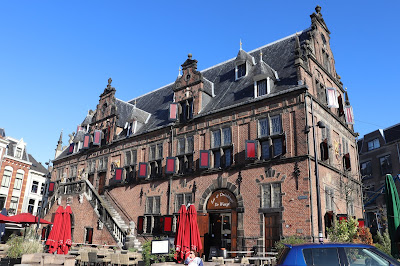The name of Netherlands came from the Roman commentary about
this being low country or swamp. It became part of the Holy Roman Empire until
William of Orange, a German Protestant,
was granted the Netherlands and Belgium by the King of Spain after William
had become Catholic. He declared that the Netherlands would have religious
freedom. The Dutch national anthem still has lines about having German blood
and giving honor to the king of Spain. The Dutch founded the East India
Company, which shipped spices from the East to Europe, making the Netherlands
the richest in the world, having 12% of the world's wealth. Today, the country has
a large social welfare system. Everyone has housing, health insurance, and free
schooling. The public housing, we saw was nice and well maintained. If you
can't work the state will provide you with a minimum monthly income. Tax rates
vary from 18 to 58% to support this system.
We landed at Nijmegen
in the fog and rain. After a lecture on Operation Market Garden.
We walked the town. We passed a tax station and a weigh station for collecting
shipping taxes. Then came upon a plaque commemorating the names of the Jews who
died in concentration camps. World War II was a dark period in the Netherlands'
history, 92% of the Jews were terminated. The old town has St. Steven's church,
an ecumenical church. We tried some of the local delicacies: pickled herring (not
to my taste) and gouda cheese (the aged cheese was great).
In the afternoon, I walked to the Belvedere watchtower and Valkhof. Originally, Charlemagne built a wooden palace on this hill. In 1155, the Emperor replaced it with a stone stronghold. Most of the castle has been torn down except for the remains of two chapels.
Operation Market Garden
 |
Captured Bridge |
Our speaker was six years old in September 1944. He came to know General Gaven and several of the soldiers over time. Operation Market Garden was a plan from General Montgoery to circumvent the Ziegfield line protecting Germany by liberating northern Netherlands and going around it to secure a bridgehead across the Rhine. It involved taking a key 100-mile-long road in less than two days before reinforcements could arrive. Three airborne troops landed at various points along the road to secure nine bridges with Nijmegen being the central city. Here the Americans managed to take the town before the railroad bridge could be destroyed. Unfortunately, the British paratroopers north of here dropped on top of two divisions of SS troops and were defeated. From here the Americans tried to cross the Rhine with small boats but were turned back by the Germans. The town of Nijmegen was the farthest north point held by the Allies until after the battle of the Bulge. The attempted crossing is memorialized at sunset every night.




No comments:
Post a Comment